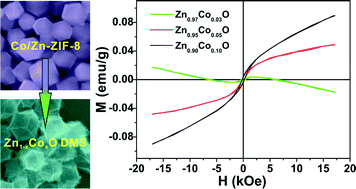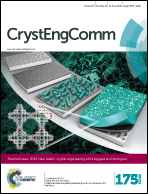Templated synthesis of diluted magnetic semiconductors using transition metal ion-doped metal–organic frameworks: the case of Co-doped ZnO
Abstract
At present, the deliberate and controlled doping of transition metal ions in semiconductor hosts remains a challenge for the development of diluted magnetic semiconductors (DMSs) with room-temperature ferromagnetic properties. In this work, Co-doped ZnO (Zn1−xCoxO, x = 0.03, 0.05, and 0.10) with different Co doping concentrations were successfully prepared via a simple thermal decomposition process using Co-doped Zn-containing metal–organic frameworks as precursors. X-ray diffraction and Raman scattering studies confirmed the incorporation of Co into the ZnO lattices. X-ray photoelectron spectroscopy indicated that the substituted Co ions were in the 2+ oxidation state and were incorporated at Zn2+ sites. The as-prepared Co-doped ZnO samples displayed an extended light absorption range compared to pure ZnO and were ferromagnetic at room temperature. Given the widely tunable range of the doping concentrations used and the abundance of metal–organic framework resources, the proposed synthetic strategy is potentially applicable to the fabrication of other transition metal ion-doped DMSs.

- This article is part of the themed collection: 2016 New talent

 Please wait while we load your content...
Please wait while we load your content...